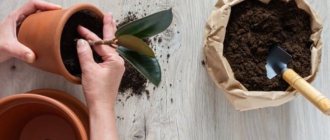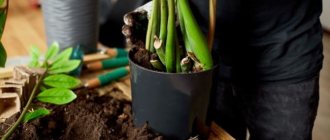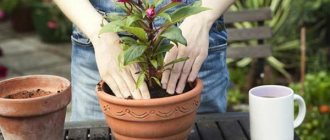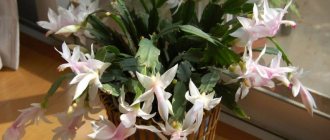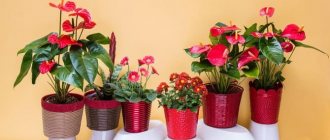- September 23, 2018
- Houseplants
- Yulia Kazakova
From time to time it is necessary to replant home flowers, otherwise they will wither or cease to please with their beautiful views. Any indoor plant needs to be replanted, since the amount of nutrients in its support gradually decreases. Each type of home flower has its own replanting frequency, depending on many factors. An important role in this process is played by the soil mixture, the container into which the flower will be moved, and compliance with the basic rules. It's worth figuring out when to repot indoor plants.
Transfer time
When to replant indoor plants depends on several factors:
- The plant did not produce flower stalks or new leaves during March.
- The leaves become smaller, and the indoor flower itself grows slowly.
- Roots are visible from the drainage holes, or the roots completely wrap around the earthen ball.
- The root system is in poor condition, since the soil mixture is not suitable for this type of flower.
Spring (late February to April) is the best time to replant indoor plants. The flower has come out of dormancy, and new shoots and leaves begin to appear on it. Transplantation is an impetus for the powerful development and growth of the plant during the growing season.
How to transplant flowers at home correctly
How often do you need to water indoor plants?
In principle, replanting a plant is easy, but not everyone can do it correctly, taking into account all the factors. The land plays the biggest role in this matter. After all, it depends on it whether the flower will bloom and smell fragrant, or whether it will begin to hurt or die.
Removing a plant from a pot
To remove a flower from a pot, you need to make sure that the earthen ball is moist and viscous. This will make it easiest to remove the plant from the pot.
To pull out a flower, you need to pass the crown of the plant between your fingers and, holding the soil, remove the lump, pressing on the sides of the container if the pot is made of plastic.
If not, then you need to tap the walls of the pot with progressive light movements, turning it around its axis, and then try to tap on the bottom of the container.
Removing a plant from a pot
Inspection and pruning of the root system
It is worth cutting off the roots of a transplanted flower only as a last resort, if the root system is diseased and there are affected areas. After trimming, it is better to treat the cut areas with crushed activated carbon.
Post-transplant care requirements
After transplantation, a flower requires a rather reverent attitude. It is necessary to constantly monitor its condition, spray it with water from time to time, look at how the plant behaves, whether growth is observed, etc.
You can spray the transplanted flower with a special preparation called Zircon once every 7 days. It helps reduce plant stress and strengthen its root system.
Watering should be done less frequently than usual so that the root system strengthens and grows further, in search of moisture.
Attention! You should start feeding the flower only a month or more after transplantation.
When to replant different types of indoor flowers
In summer, indoor flowers can be replanted only if necessary and very carefully, following all recommendations. Plants tolerate this process most easily during the active growing season.
However, there are species that are best replanted at the beginning of winter. These include cacti and succulents. Plants that are early flowering species need to be replanted only after flowering. Domestic flowers of bulbous species are subjected to such manipulation at the end of the dormant period. Coniferous species are replanted in the summer or in February, when their growth ends.
What perennials can be replanted in spring?
Almost all perennials tolerate spring replanting well, since they have almost six months left to adapt and accumulate strength before wintering. It is advisable to monitor your flower beds and do not forget to divide those plants that are already crowded. How to understand this? The center of the bush is thickened or bare, there are fewer flowers, the color and size of the leaves change, and the plant itself is actively fighting for territory with its neighbors.
In order not to make a mistake with the timing of transplanting perennials, it is advisable to follow a simple rule - replant everything that blooms in summer and autumn in the spring, and leave everything that blooms in the spring until autumn.
- What perennial flowers are planted and replanted in the fall?
Did you know that not all plants take root well in the spring? That's why some flowers are planted in the fall!
Most often in the spring it is recommended to divide and replant the following crops:
- Spring-flowering - Arends saxifrage, fine-toothed primrose, horned violet, tomentose violet.
- Blooming in summer - buzulnik, pinnate carnation, magnificent dicentra, lanceolate coreopsis, burnet, lavender, daylilies, cornflower, hybrid feverfew, Rogersia, Korean chrysanthemum, purple coneflower.
- Autumn-flowering plants - bush aster, Japanese anemone, autumn helenium, miscanthus, sapling, brilliant rudbeckia, solidago, cohosh (black cohosh).
- Cold-growing cereals - reed grass, manna grass, mutton grass, sedge, pearl barley, bulbous ryegrass, sesleria, pike grass, maned barley.
Ban on transplantation
It is forbidden to replant home flowers that were recently purchased in a store. Also, do not disturb the plants when they are flowering, as this will cause the buds to fall off. It is also prohibited to replant flowers during the dormant period, since they will not be able to recover quickly, damaged roots will begin to rot, and without them, the fresh substrate will begin to sour. Sick plants are also not subjected to such procedures, as this will cause additional stress and aggravate the situation.
Influence of zodiac signs
Days when the Moon passes through the zodiac signs of Water and Earth are suitable for all kinds of medical procedures. During the new moon or full moon, it is better not to carry out any operations with flowers.
- Water signs
Cancer, Scorpio - they prefer to work with representatives of the flora. Therefore, any treatment is recommended on days when the Moon passes through these zodiac signs. Fish also support the replanting of plants, the main thing these days is not to overdo it with watering, this can lead to rotting of the roots.
- Signs of the Earth
If you change the pots and soil during the Taurus period, the plants will take root normally. By the time of Capricorn, replanting will result in house flowers having good immunity to disease and harmful insects, and will also be able to satisfy a strong and healthy root system. Virgo is the patroness of abundant flowering, so at this time it is worth replanting flowering potted plants.
Fire signs (Leo, Aries, Sagittarius) are not suitable for carrying out agricultural techniques for caring for plants. And the zodiac constellations of Air (Libra, Gemini, Aquarius) are neutral and are recommended for caring for flowering crops.
It is often noted that transplantation carried out under the negative influence of the moon or zodiac constellations leads to the fact that the adaptation period is very difficult for the flowers.
Types of transplantation
The following types of flower transplantation are distinguished, depending on the volume of replacement of the soil mixture:
- Replacement of topsoil. This species is mainly used for replanting large indoor plants. The old layer is removed down to 5 cm, a new one is poured on top, which must be compacted. Most indoor plants benefit from changing the top layer of soil. It is better to perform such manipulations once every 3-6 months. Together with the substrate, deposited salts and soil fungi are removed, and additional substances are brought with the new soil.
- Incomplete transplant. A little soil mixture is left on the root system.
- Complete transplant. The roots are cleaned and the entire substrate is replaced.
Let's look at the lunar calendar
The moon greatly influences the development of plants - this is scientifically proven, therefore all plantings are oriented towards the lunar calendar. The night star has a strong effect on the flow of fluids in all living organisms, so the lunar phase can make it easier or more difficult for the plant to recover.
What impact does it have?
The lunar phase changes the process of sap flow in the plant, so gardeners focus on the following four phases of the moon:
- On the waxing Moon - the interval between the new moon and the full moon. At this time, upward sap flow begins. Liquid moves from the roots to the top. There is an accumulation of energy and growth of all parts of the flower: leaves, buds, stem and flowers.
- During the full moon - the time of the full moon plus one day before and after it, the above-ground part of the flower is highly saturated with energy, so damage to the root will not greatly affect transplantation and restoration, since all the juices are in its upper part.
- On the waning moon - the period from the full moon to the new moon, the juices begin to move down to the roots. At this time, the above-ground part gradually weakens, so it is undesirable to touch the root system.
- During the new moon - the interval consists of the new moon itself plus one day before and after it, all the energy of the plant accumulates in the roots. The top part is weakened. Damaging the root system can seriously damage the flower.
Thus, the most favorable time for replanting is the full moon and the waxing moon, when damage to the root system will least harm the plant itself.
Is it possible to replant when the Moon is waning?
During this period, it is better to cancel the transplant procedure. Most of all juices and energy accumulate in the root system. By replanting, we damage part of the root system, which negatively affects the general condition of the plant. The best solution would be to move the transplant to another phase of the Moon.
Which days of the week or day do you prefer?
Flower growers who focus on the phases of the moon use the annually compiled lunar calendar.
Some gardeners consider the best days for transplanting to be days with feminine names - Wednesday, Saturday, Friday.
Handling indoor plants
Most experts do not classify this type of houseplant transplant as a separate one. Transshipment of plants is the action in which a ball of earth is transferred to a larger container, and a soil mixture is added to it on top and on the sides. After this, the indoor plant is watered.
Transshipment is the safest option for plants. Most often it is used when the roots in the old pot no longer fit and are visible in the drainage holes. It does not provoke growth retardation in plants, so you can transship at any time of the year.
Transshipment is recommended for those plants that are actively growing and for those that do not cope well with transplantation (palm trees).
Favorable and unfavorable days of the year
Research by scientists confirms the influence of the moon on the movement of water, periodic vertical fluctuations in the level of the World Ocean, and the movement of plant sap from the root system to the foliage. Therefore, care must be coordinated with the lunar calendar, transplants only on favorable dates.
NOT favorable days in 2022:
In addition, when planning an event, the florist must be guided by the stage of cultural development, due to which the period of operation may not coincide with pre-planned actions according to the phases of the moon and the general influence of the night luminary.
Choosing a pot for replanting a houseplant
The depth and width of the pot depends on the type of plant roots. It is recommended to choose a container size so that the previous one can easily fit into it. For young plants, a pot 2-3 cm larger is suitable, for adults - 3-5 cm. It is better to replant indoor flowers in a container only slightly larger than the previous one, rather than immediately using one that is too large.
The plant benefits from regular renewal of the substrate, and if the size of the pot is too large, the properties of the soil, free of roots, will quickly deteriorate.
There are plants that prefer to grow in a cramped pot. These flowers include: hippeastrum, epiphytic orchids. The main reason for the lack of flowering in hippeastrum is precisely the overly large pot.
Data for calculating the date of sowing seeds for seedlings
| Culture | Average growing season | Seedling age | Germination time |
| Watermelon | early varieties: 65-80 days, mid-late varieties: 85-95 days, late varieties: 88-110 days | 20-25 days | 3-7 days |
| Basil | 140-160 days | 45 days | 5-7 days |
| Eggplant | early varieties: 100-110 days, mid-season varieties: 120-140 days | 50-60 days | 7-10 days |
| Melon | early varieties: 63-75 days middle varieties: 78-90 days late varieties: 95-135 days | 20-25 days | 3-7 days |
| Strawberries | perennial crop | 50-70 days | 10-30 days |
| Zucchini | 40-60 days | 20-25 days | 2-4 days |
| White cabbage | early varieties: 85-100 days middle varieties: 100-130 days late varieties: 140-180 days | 45 days | 3-4 days |
| Potato | early varieties: 40-70 days mid-season varieties: 75-90 days late varieties: 95-120 days | 30-40 days | 5-8 days |
| Cucumber | early varieties: 37-45 days mid-season varieties: 45-55 days late varieties: 55-70 days | 20-25 days for open ground 30-35 days for greenhouses | 2-4 days |
| Pepper | early varieties: 80-110 days mid-season varieties: 110-125 days late varieties: 130-150 days | 50-60 days | 7-10 days |
| Celery | 140-200 days | 60-70 days | 7-10 days |
| Tomatoes | early varieties: 70-100 days mid-season varieties: 111-125 days late varieties: 115-130 days | tall: 50-60 days medium-sized: 50-55 days standard: 40-45 days | 5-8 days |
| Pumpkin | early varieties: 95-100 days mid-season varieties: 100-120 days late varieties: 125-150 days | 20-25 days | 2-4 days |
Required soil mixture
Indoor flowers of different types have their own individual needs, so the soil mixture for each must be special.
The substrate, as a rule, is prepared in the same way as the previous one; it can also be supplemented with drainage and fertilizers in the form of powdered banana peels and wood ash.
If a specially designed mixture was purchased for the plant, before replanting it is necessary to open the packaging to ventilate the nitrogen so that the roots are not damaged.
If you prepare the soil mixture yourself, you need to sterilize the garden soil. It is best to choose the soil under coniferous trees, as it is lighter and looser. It is also recommended to steam it in the oven for about an hour at a temperature of 80-100 degrees or heat it in a water bath or in the microwave.
It would be best to sterilize the purchased mixture too, this way you can protect yourself from unpleasant consequences.
Trimming
Experts do not recommend pruning the plant during replanting, as this will be double stress for it. However, climbing and hanging plants are shortened to leaves that were formed at the end of last year. For example, in ficus, overwintered indoor roses, geraniums, and fuchsias, most of the shoots are cut off, leaving 4-5 buds. This is done to rejuvenate the plant.
The main rule when pruning a shoot is to end it at the bud pointing outward, this is done so that the flower grows beautiful and strong. If you prune differently, the shoots will begin to grow inside the bush, which will give it less decorative value and poor development.
How to properly replant plants purchased in a store.
For a plant to adapt to a new place, it needs time, about two to four weeks. If it was purchased in winter or autumn, then it is better to wait until March and then replant it. You should not do a complete transplant, but it is better to resort to carefully transferring the flower into a slightly damp substrate.
Many gardeners are of the opinion that the purchased plant must be urgently removed from the transport soil. Experts recommend refraining from replanting for now, since often when the transport soil is removed, the root system is damaged, after which it can be very difficult for the plant to recover. This substrate does not cause harm, and the strong entwining of the roots around the ball indicates that the plant is quite comfortable and grows in it for a long time. Before sale, this soil is very well saturated with all kinds of nutrients, which are enough for 2-3 months. At the same time, it has excellent breathability and good water absorption.
If after purchasing a flower you have doubts about its health, you can try to carefully remove it along with the earthen lump from the pot. If the roots of the flower are black and soft, with an unpleasant aroma, you should replace the soil mixture, cut off the affected roots and treat them with charcoal powder. Then the plant should be replanted in a new nutrient mixture, placed under film or glass to increase humidity, which will help the formation of new roots.
If you treat plants with due attention, follow the rules and know when you can replant indoor plants and when not, take care of them on time, water them, then they will please the eye for many, many years to come.
Preparation of drainage and soil mixture
A good soil mixture is the key to successful and healthy growth of indoor plants. The type of soil mixed depends on the specific plant for which it is intended.
Classic earth mixture
Automatic watering for indoor plants - do it yourself
For many plants, a classic soil mixture is suitable. The so-called “mix” of leaf soil or humus, garden soil, peat and river sand. All “ingredients” are mixed in equal quantities to each other, that is, 25 percent each.
If problems arise with river sand, you can easily replace it with perlite. Botanists recommend adding a little expanded clay to the resulting soil, after which everything needs to be mixed. This soil is suitable for any ficus and other indoor plants.
Soil mixture for ferns
The soil for ferns differs from the classic one in that it must have an acidic environment.
It usually consists of leaf soil (1/4 of the total volume) and humus (1/4). The remaining 50 percent is covered by heather soil. To all this you need to add a little hydrogel so that the moisture does not stagnate.
Earth mixture for succulents
A characteristic feature of such soil is that the moisture inside it should not stagnate. Succulents are very sensitive to soil and therefore require great care when composing.
River sand will take up about 1/3 of the entire mixture, the other third will be taken by compost, and finally, the remaining part is divided in half between perlite and peat.
Drainage
Properly designed drainage during transplantation is the key to good flower growth; there is nothing complicated about it.
Attention! Typically, drainage is poured in a layer of 1 to 3 centimeters, at the very bottom of the pot.
It is best to use pebbles, gravel or expanded clay as drainage, and the whole thing is seasoned with vermiculite and agroperlite for better moisture transmission through the soil.
Drainage for indoor plants

